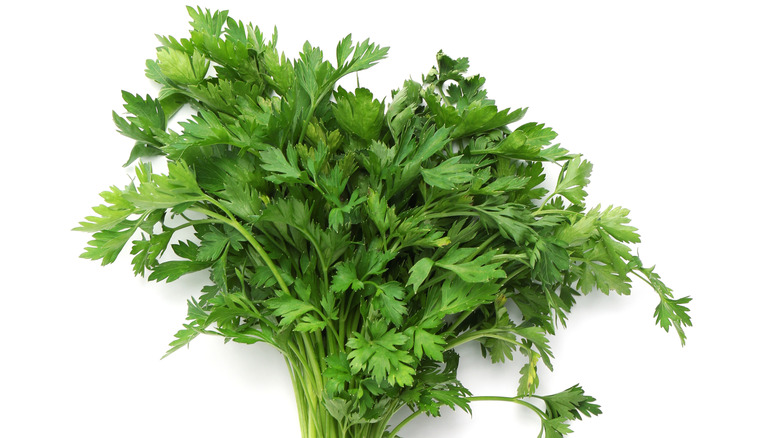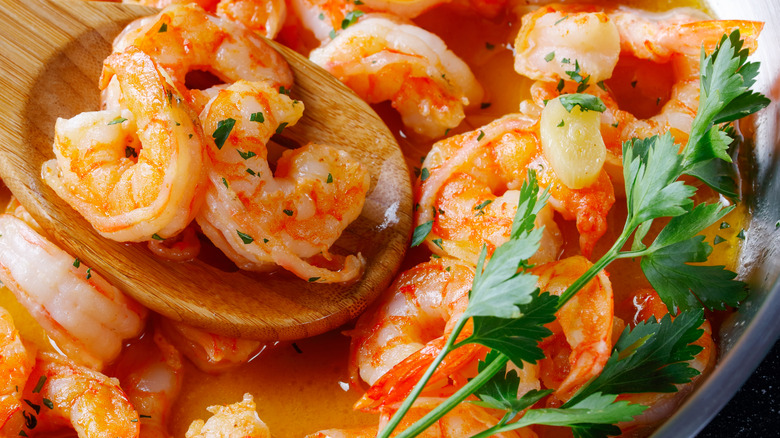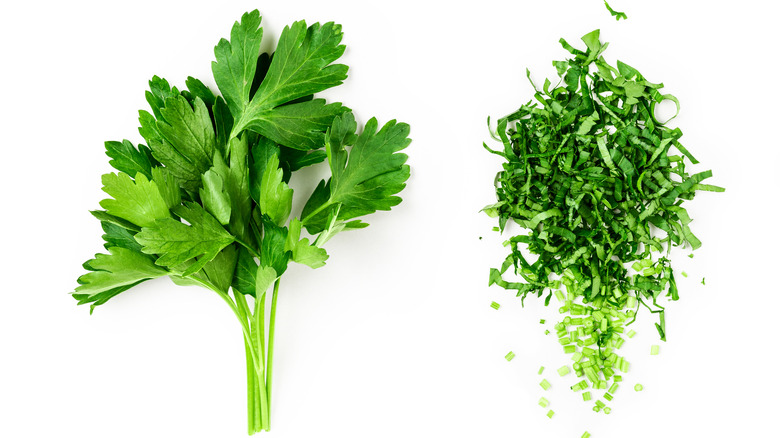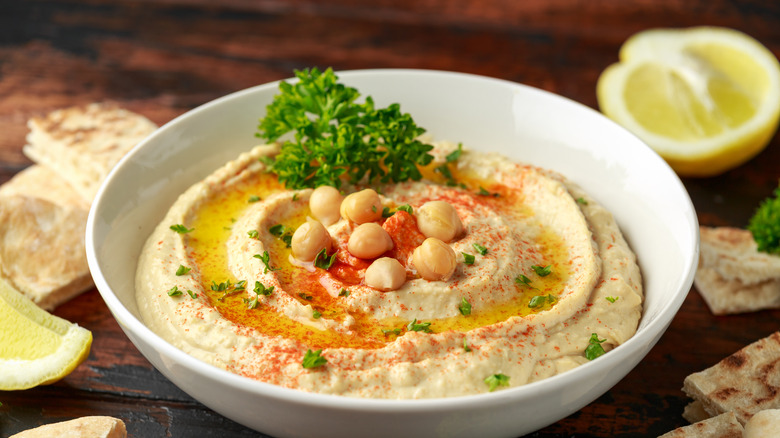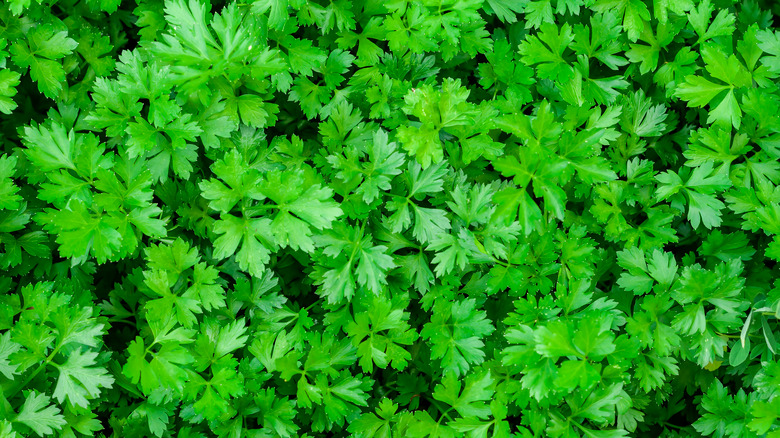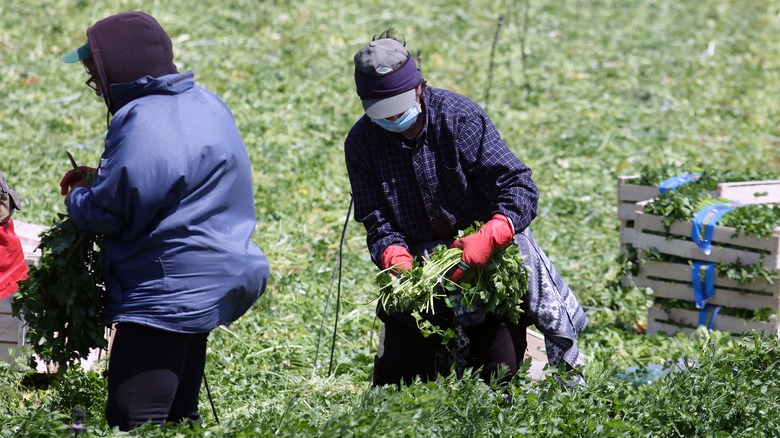What Is Parsley Really And What Does It Taste Like?
We may receive a commission on purchases made from links.
You've seen it on your steaks. You've seen it on your eggs. You've probably seen it the most on those fancy, glossy pictures food magazines use for their cover spreads. You might have thought it was some kind of plastic decoration the waiter put on your food for a laugh and never touched it. No matter where you go or what you try, you've probably eaten this little green plant more times than you realize.
MasterClass tells us that parsley is a member of the Apiaceae family. The herb is better known to the scientific community as Petroselinum crispum (but since we're not scientists we're just calling it parsley and leaving it at that) and is one of the most versatile vegetables in the culinary world, with its applications ranging from being a simple fancy flourish on your prime rib or dried and sprinkled atop your soup. Decorative? Absolutely, with its bright green a delightful contrast against the main course. But there's so much more to the humble garnish.
The origins of parsley
Unfortunately, the exact details of the parsley plant is unknown, although a few sources have emerged to shed some light on its culinary background. According to MasterClass, parsley is native to the Mediterranean region, first been grown in the rocky hills and valleys of Greece. In fact, the "Petro" in its scientific name, Petroselinum crispum, is Greek for "stone," so parsley is quite literally known as "rock celery."
The Schwartz website agrees with the idea of the plant's origins being Greek in nature, but also relates that the ancient Romans wore parsley around their necks out of a belief that it could prevent drunkenness. Famed Swedish taxonomist and botanist Carl Linnaeus stated that parsley was apparently cultivated in Britain for the first time in 1548. No matter where it is grown (or how it's worn, in some cases), the biannually-grown crop is still widely used in all sorts of culinary dishes in the Mediterranean and, obviously, all around the world.
A taste of green
It'd be easy to assume that parsley doesn't have any actual flavor. Most of us probably put it to the side when we begin our meal; it serves just as decoration, rather than food. In reality, parsley is described to have a peppery, slight bitter taste to it, says MasterClass, a flavor profile that is so "clean" that it helps to neutralize certain strong flavors and particularly savory dishes. Just like the humble apple, parsley has several different varieties, as Gardening Know How relates, each with its own look and flavor profile.
Flat-Leaf Parsley which is the most common parsley out there (and the one we've been talking about so far). Curly-Leaf Parsley can be identified via its ruffled leaves and its uniquely muted, "grassy" taste. Hamburg, or the Parsley Root, which is traced back to Germany and is identified by large, thick roots and larger leaves. Its flavor profile is reminiscent of "carrots meeting celery." Japanese Parsley (Mitsuba) can be located in Japan and other Asian countries. It has thick, edible roots and is said to have a clean flavor, with notes of coriander, celery, and sorrel.
Cooking with parsley
You'd be forgiven if you think parsley is nothing but a fancy garnish. There is a multitude of ways one can cook with it, thanks to its rich and herbaceous flavor. That applies to both fresh and dried types of parsley, either from your garden or from your neighborhood market's produce aisle.
Use it to make a salad. (We recommend trying Alton Brown's parsley salad recipe, posted at Food Network, first!) It makes a terrific base in stews and soups. The French use parsley in what they call a "bouquet garni" — as Culinary Hill explains, it's fresh herbs tied together and tossed into stocks to add more flavor.
Parsley-garlic butter is another favorite, for its taste and for its ease of preparation. Just mix butter, garlic, parsley, and bit of lemon zest, and spread it on some good, crusty bread. (Epicurious offers an actual recipe.) The A Couple Cooks website offers a recipe for chimicurri, which is a velvety smooth herb sauce that goes great on rich, flavorful types of fish like salmon.
Of course, like all good things, if used too much, parsley can completely overwhelm a dish with its herb-y flavor. Be mindful of how much you use.
Parsley: an underappreciated superfood
By now, it's clear that parsley is more than just a disposable decoration in a restaurant. Even more, parsley is actually jam-packed full of so many vitamins and nutrients that it seems almost absurd that all of it can fit into one tiny sprig. Writing for Healthline, Maria Zamarripa lists the astounding ways parsley can improve your life.
Parsley contains very few calories and is filled with Vitamins A, C, and K. It's loaded with antioxidants, some thought to help to prevent cancer, and contributes to good bone health. It's also thought by some to contribute to improved heart health, and is advantageous for healthy eyes. Its extract has antibacterial properties, too. It also is said to freshen one's breath.
Unlike some superfoods that may be cumbersome to fit into one's diet, parsley is absurdly easy to include. This nutritional dynamo can be added to just about any dish you choose.
Our beloved green leaf
Parsley may not be generally regarded as the superstar of foods, or the most highly sought-after ingredient by food critics and bold professional chefs, but that's not to say this leafy fellow doesn't have its benefits. It's affordable and commonly found, both dried and fresh, in just about any neighborhood grocery or supermarket. Its uses are vast and adaptable to any just about any situation, be it breakfast, lunch, or dinner (or, for that matter, a savory, herby snack). Its health benefits are immense and a key way to stay well. It is a simple, humble, but all-around delicious and treasured member of the herb family, and you will be doing yourself a favor if you decide to add a bit of green leafy goodness to your next soup or other main dish. (Check out The Kitchn for a list of parsley-centric recipes.)
It's both beautiful and highly nutritious. Next time you find a parsley sprig decorating your plate at your favorite restaurant, give it a little love, a little respect. Give it a taste. You might be pleasantly surprised.
